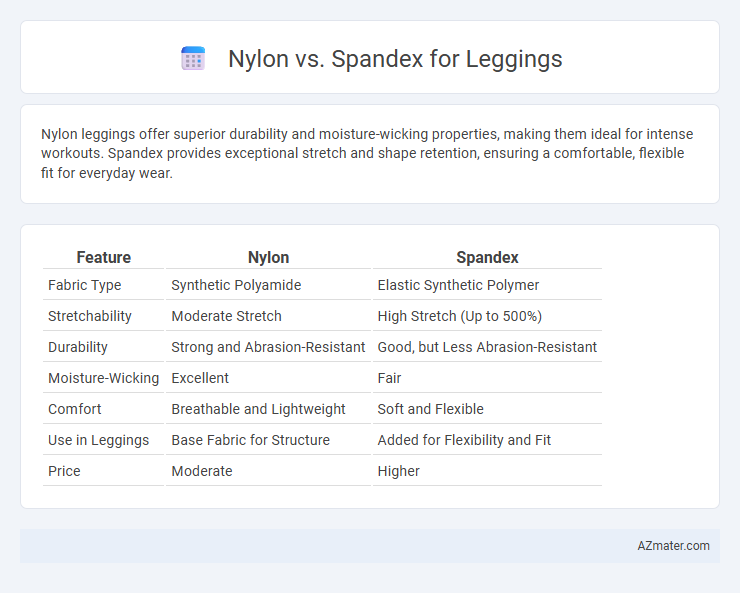Nylon leggings offer superior durability and moisture-wicking properties, making them ideal for intense workouts. Spandex provides exceptional stretch and shape retention, ensuring a comfortable, flexible fit for everyday wear.
Table of Comparison
| Feature | Nylon | Spandex |
|---|---|---|
| Fabric Type | Synthetic Polyamide | Elastic Synthetic Polymer |
| Stretchability | Moderate Stretch | High Stretch (Up to 500%) |
| Durability | Strong and Abrasion-Resistant | Good, but Less Abrasion-Resistant |
| Moisture-Wicking | Excellent | Fair |
| Comfort | Breathable and Lightweight | Soft and Flexible |
| Use in Leggings | Base Fabric for Structure | Added for Flexibility and Fit |
| Price | Moderate | Higher |
Introduction to Nylon and Spandex Leggings
Nylon leggings are renowned for their exceptional durability, moisture-wicking properties, and smooth texture, making them ideal for intense workouts and daily wear. Spandex leggings offer superior stretch and flexibility, ensuring a snug fit that moves effortlessly with the body while providing excellent shape retention. Combining nylon and spandex creates leggings that balance strength, comfort, and elasticity, enhancing performance and style.
Material Composition: What Sets Nylon and Spandex Apart
Nylon is a strong, durable synthetic fiber known for its resistance to abrasion and moisture-wicking properties, making it ideal for longevity and comfort in leggings. Spandex, also called elastane or Lycra, is highly elastic and provides exceptional stretch and recovery, allowing leggings to maintain shape and offer superior flexibility. The combination of nylon and spandex in leggings optimizes performance by balancing durability with stretch, enhancing fit and comfort for activewear.
Comfort and Fit: Nylon vs. Spandex Performance
Nylon offers superior durability and moisture-wicking properties, making leggings comfortable for extended wear and intense workouts by keeping skin dry and reducing irritation. Spandex provides exceptional elasticity and stretch, allowing leggings to conform closely to the body for a snug, flexible fit that moves with every motion. Combining nylon with spandex enhances performance, delivering leggings that balance support, comfort, and freedom of movement for optimal fit and wearability.
Durability and Longevity Comparison
Nylon leggings excel in durability due to their strong synthetic fibers, offering excellent resistance to abrasion, tears, and frequent washing, which contributes to a longer lifespan. Spandex, while highly stretchable and flexible, tends to degrade faster under repeated stress and exposure to heat, resulting in reduced longevity compared to nylon. Choosing nylon blends for leggings ensures better durability and sustained fit, making them ideal for intensive activities and long-term use.
Moisture-Wicking and Breathability Face-Off
Nylon leggings excel in moisture-wicking due to their synthetic fiber structure, which rapidly draws sweat away from the skin, enhancing comfort during intense workouts. Spandex offers superior breathability with its stretchy, lightweight composition that promotes airflow and prevents overheating, making it ideal for extended wear. Combining nylon's moisture management with spandex's ventilation ensures optimal performance and comfort in activewear leggings.
Color Retention and Fade Resistance
Nylon leggings exhibit superior color retention due to their strong fiber structure and resistance to UV damage, maintaining vibrant hues even after multiple washes. Spandex, while offering excellent stretch, tends to fade faster because its elastomeric fibers are more prone to color degradation under prolonged exposure to sunlight and heat. Choosing nylon blends ensures leggings retain their original color intensity and fade resistance, enhancing durability and lasting aesthetic appeal.
Stretch and Recovery: Which Offers More Flexibility?
Nylon offers durability and a smooth feel but typically provides less stretch compared to spandex, which is known for its superior elasticity and exceptional recovery. Spandex can stretch up to 500% of its original length, allowing leggings to contour tightly to the body and maintain shape without sagging. When choosing leggings for maximum flexibility and retention, spandex-enhanced fabrics outperform nylon by delivering greater stretch and quicker recovery.
Care and Maintenance: Nylon vs. Spandex Leggings
Nylon leggings require gentle washing in cold water and air drying to maintain fiber strength and prevent pilling, while spandex leggings need special attention to avoid heat exposure that can degrade elasticity and cause fabric thinning. Both fabrics benefit from avoiding bleach and fabric softeners, which can break down fibers and reduce garment lifespan. Proper care extends the durability of nylon's abrasion resistance and spandex's stretch recovery, ensuring leggings retain their shape and color over time.
Price Differences and Value for Money
Nylon leggings generally offer higher durability and moisture-wicking properties, making them a premium choice with a slightly higher price point compared to spandex leggings. Spandex leggings tend to be more affordable and provide superior stretch and flexibility, delivering excellent comfort for everyday wear. Evaluating price differences, nylon leggings may represent better long-term value due to their resilience, while spandex leggings appeal to budget-conscious buyers prioritizing elasticity and softness.
Which is Better for Leggings: Nylon or Spandex?
Nylon leggings offer superior durability, moisture-wicking properties, and a smooth, lightweight feel, making them ideal for high-performance activities. Spandex provides exceptional stretch and shape retention, ensuring leggings maintain a snug fit and flexibility during movement. Choosing between nylon and spandex depends on whether durability and breathability or maximum elasticity and comfort are the primary priorities for your leggings.

Infographic: Nylon vs Spandex for Legging
 azmater.com
azmater.com